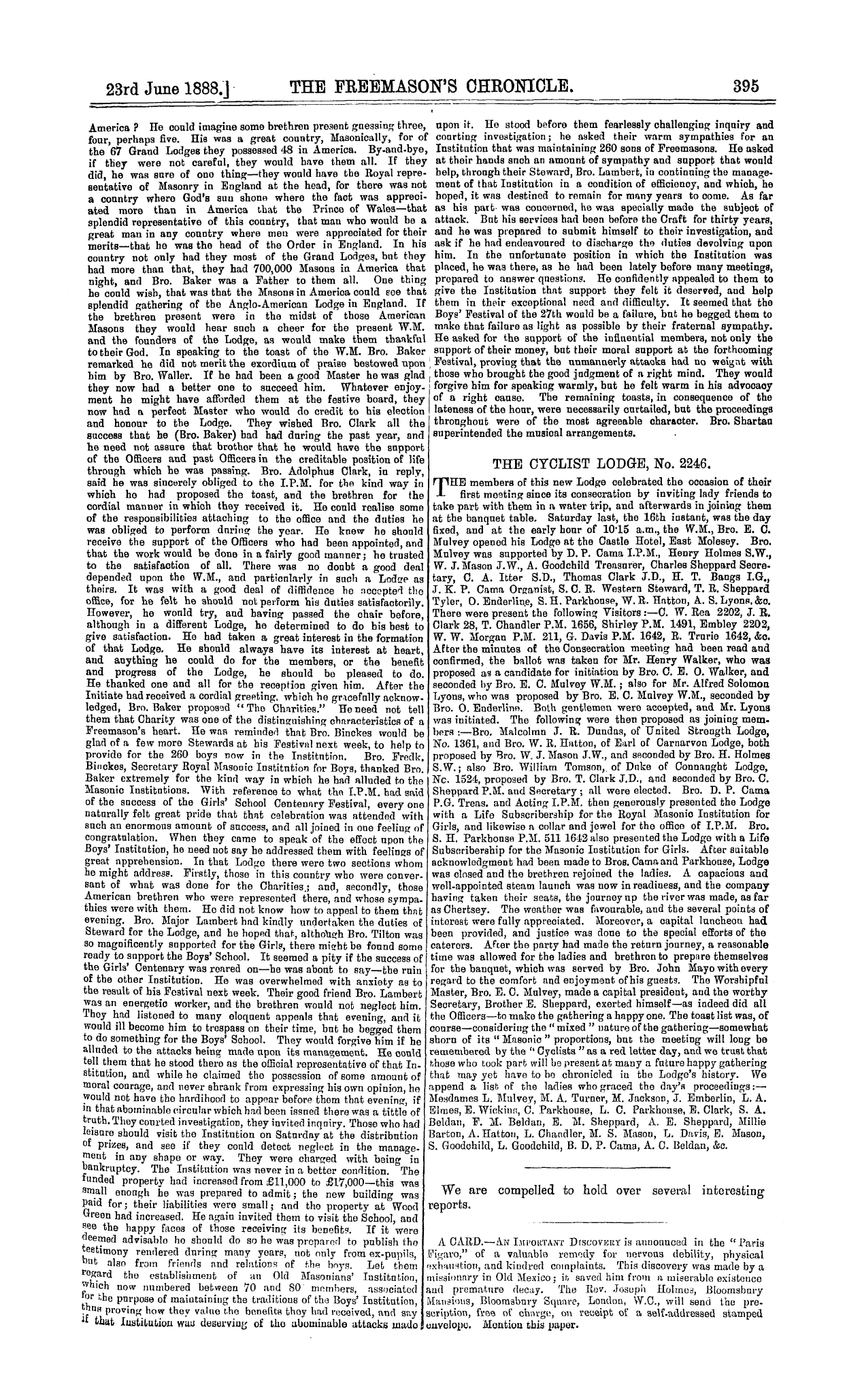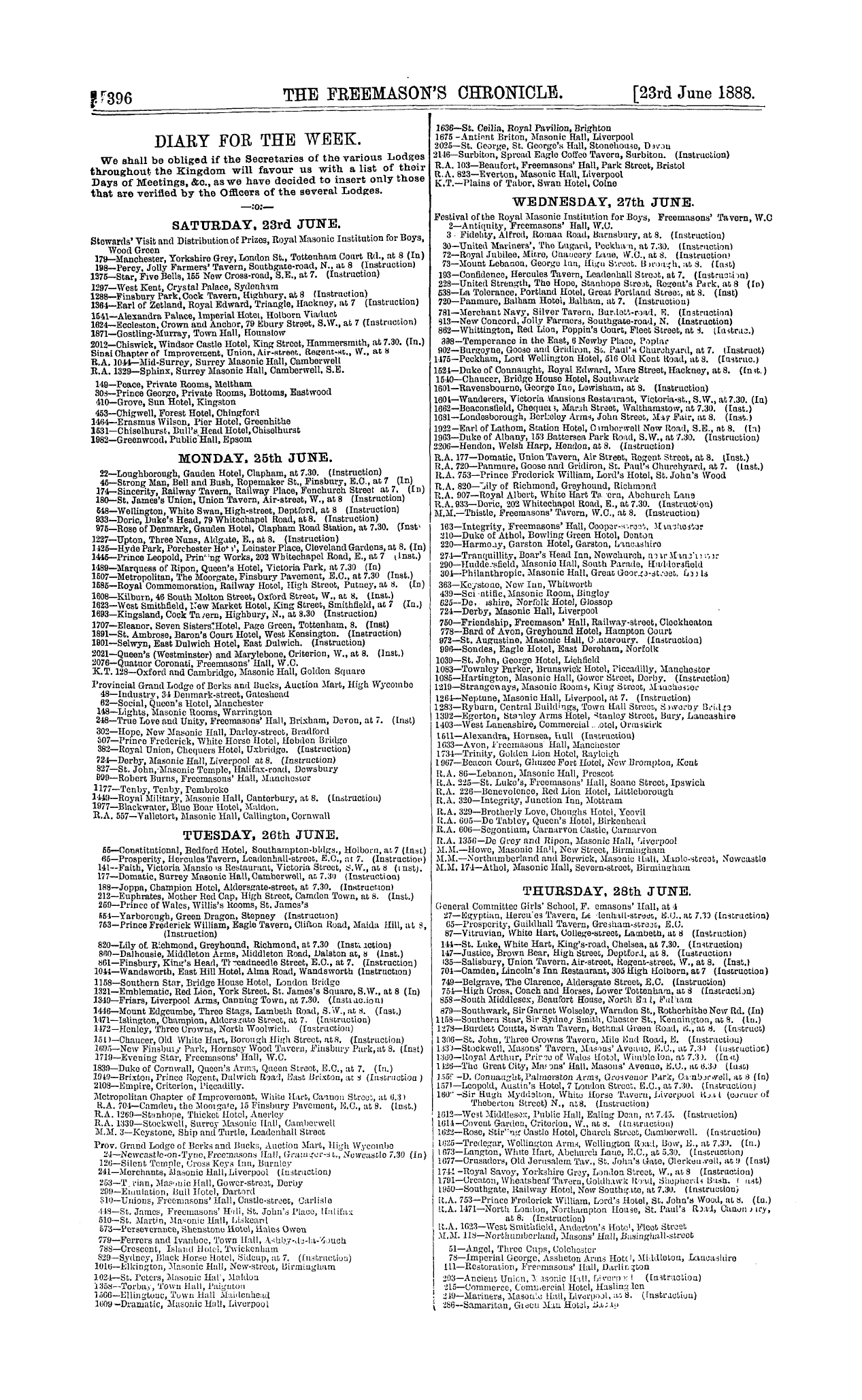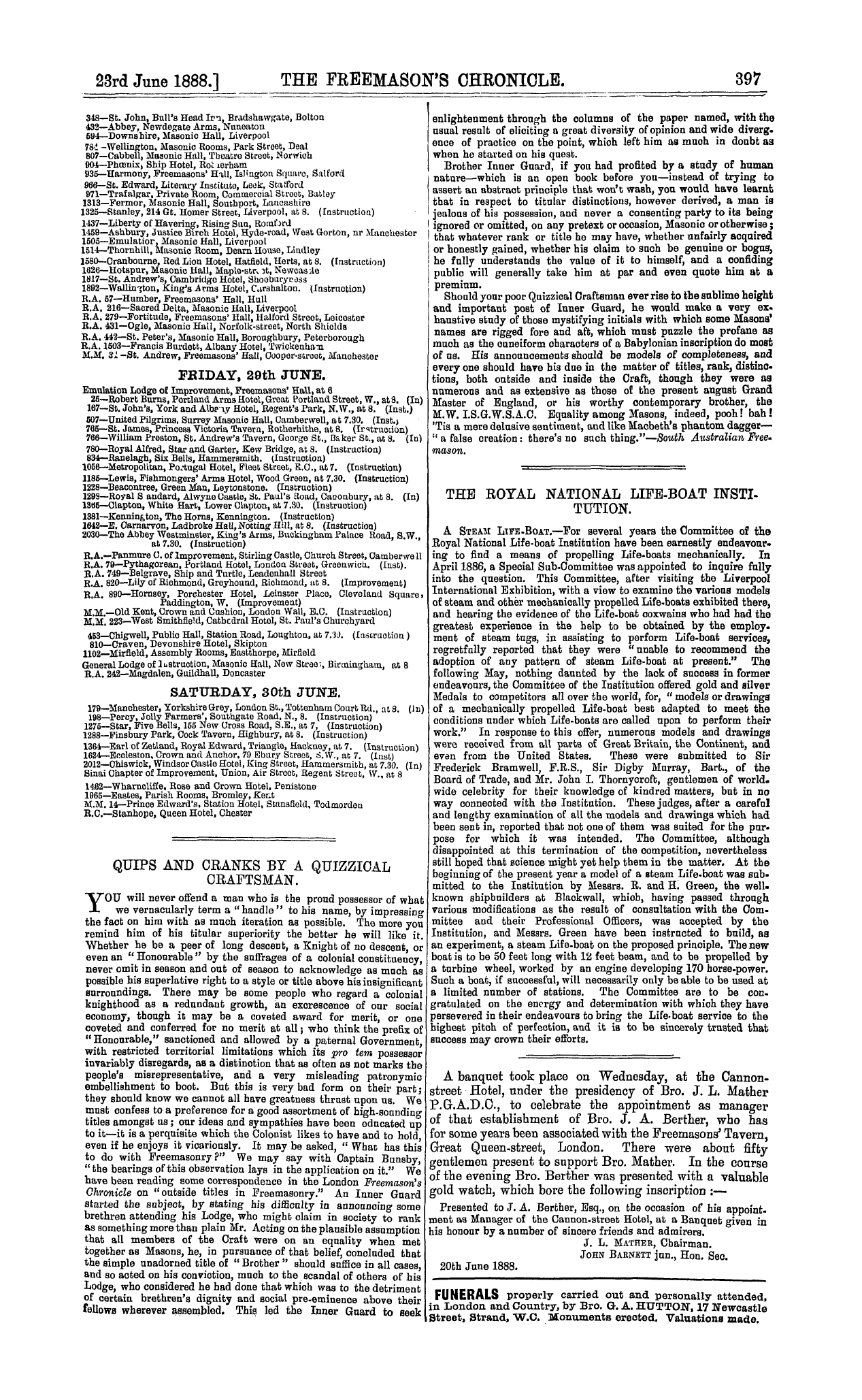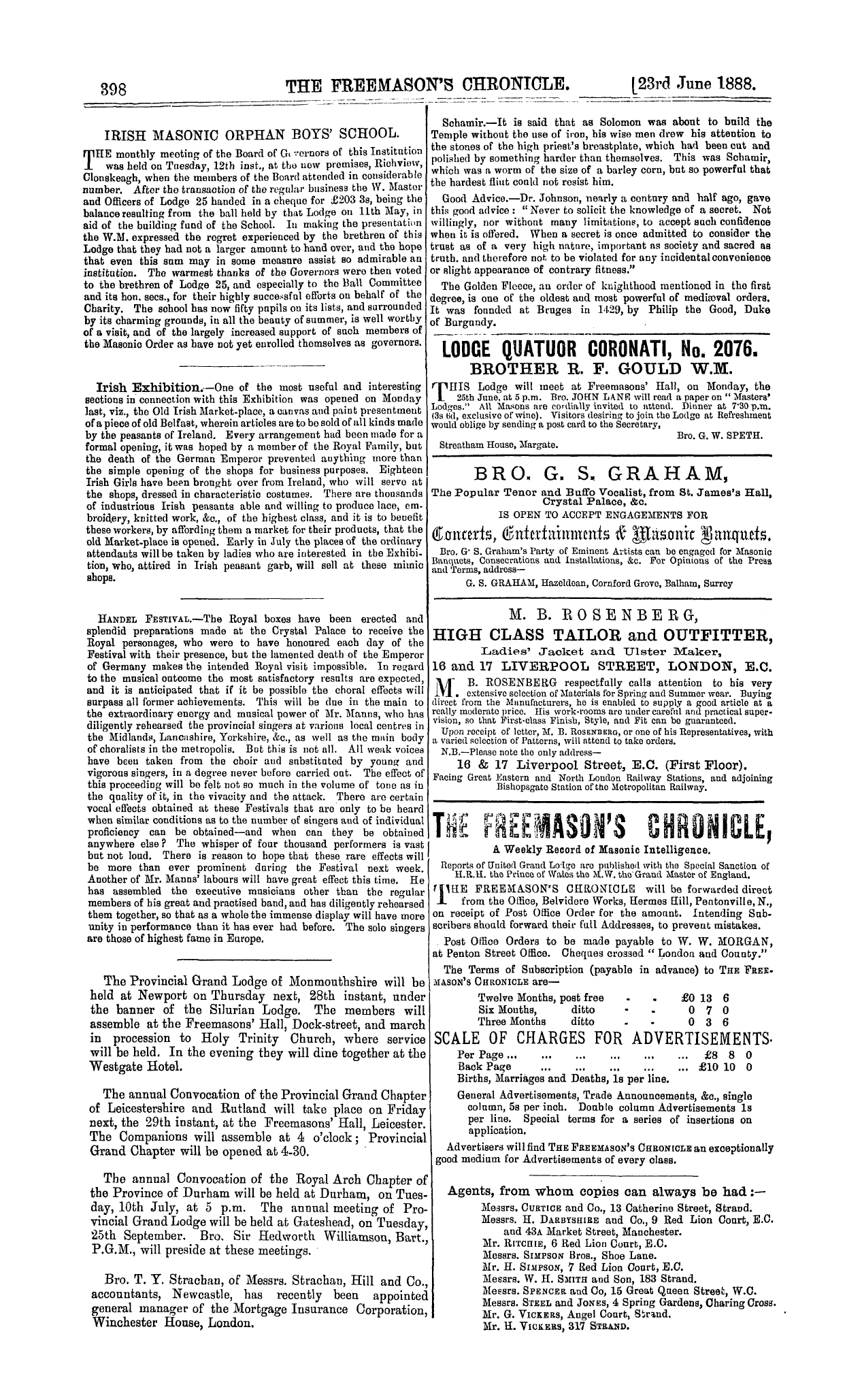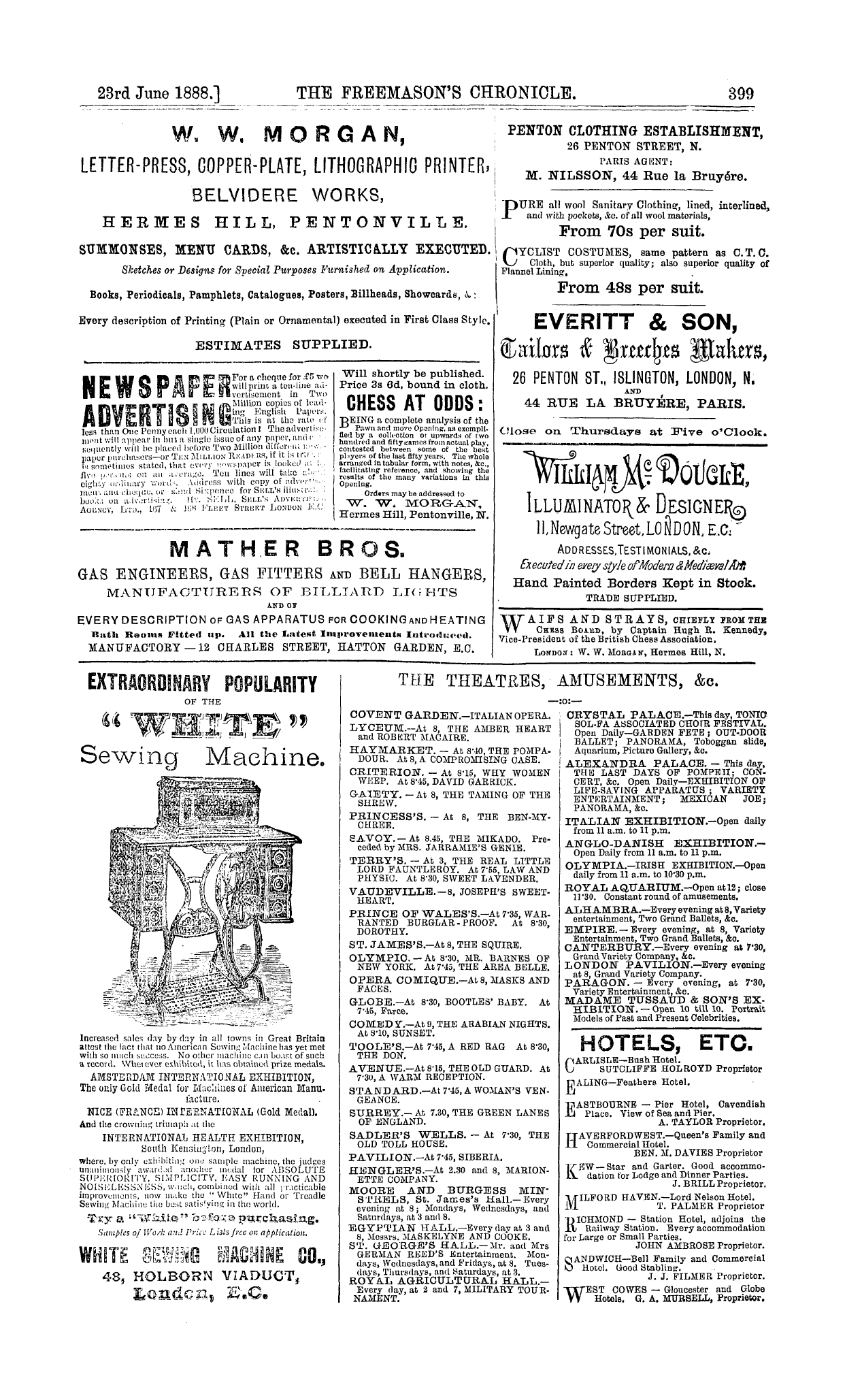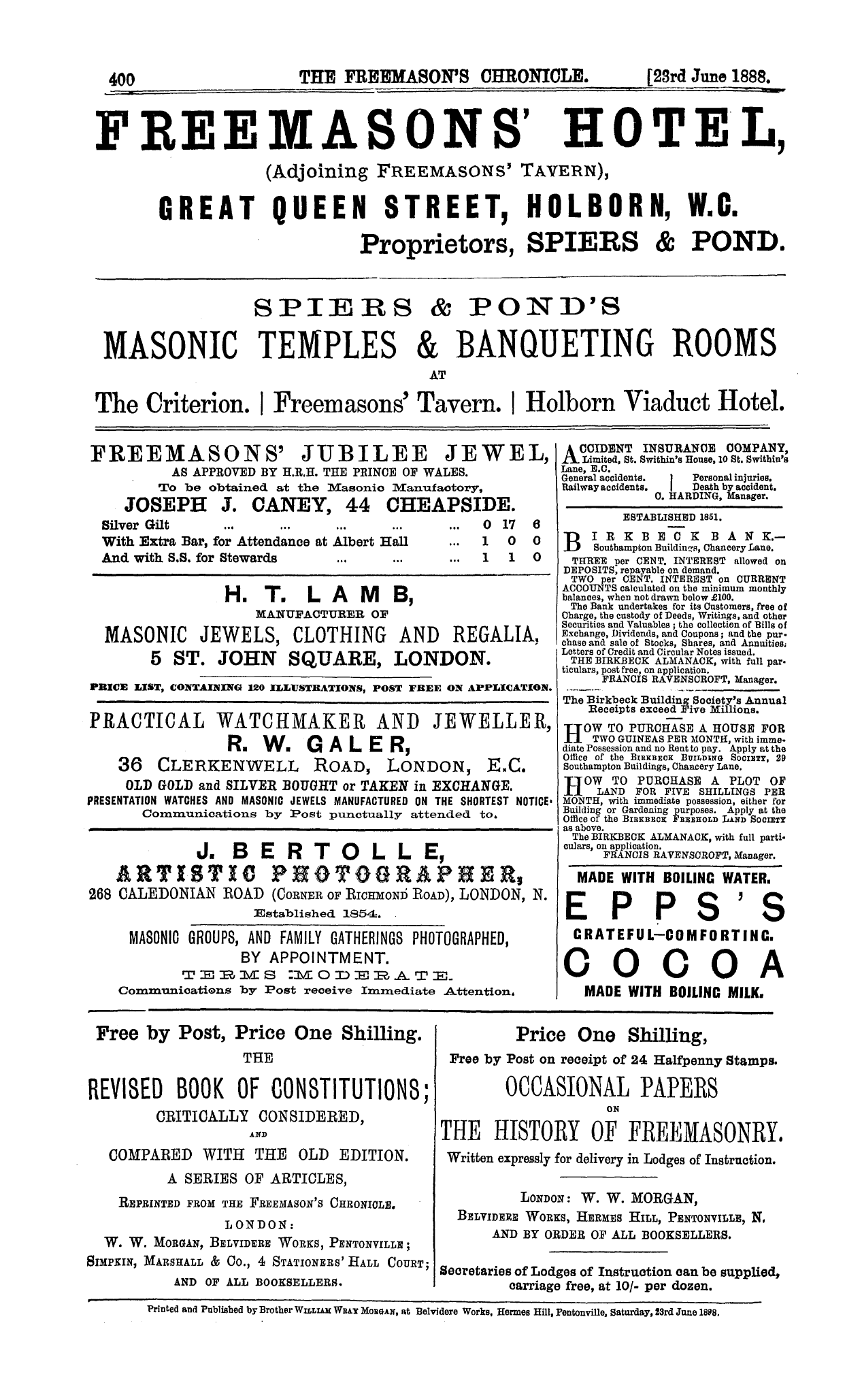-
Articles/Ads
Article BLUNDERING SECTARIAN SYMBOLMONGERS. Page 1 of 2 Article BLUNDERING SECTARIAN SYMBOLMONGERS. Page 1 of 2 →
Note: This text has been automatically extracted via Optical Character Recognition (OCR) software.
Blundering Sectarian Symbolmongers.
BLUNDERING SECTARIAN SYMBOLMONGERS .
BY BEO . JACOB NORTON . "VTEW religions are promulgated either by arguments JLi or by miracles , but when the priesthood becomes
powerful , religious persecution is resorted to for driving people into the church and for preventing others from leaving it . In the middle ages , besides persecution , Jews have often been challenged by Christian clergy to public or private discussion , and Prince de Joinville , in his Chronicles of the Crusades , relates several anecdotes which were
told to him by St . Louis , one of which is as follows : — " Afc another time the holy King told me , that dnring the great disputation afc the monastery of Olugny , between the monks and the Jews , an old Knight happened to be present , who requested tbe abbot of fche monastery to allow him to say a few words ; this with difficulty was granted to him . The old Knight , raising himself on
hia crutches , desired the more learned clerk and first rabbi of the Jews to come near to him , whioh being done , the Knight pnt the following questions to the rabbi : Do yon believe in the Virgin Mary , who bore our Lord Jesus Christ in her womb , and then in her arms , and that she was a virgin when delivered , and is now the
Mother of God r The Jew replied that he did nofc believe a word of all this . The Knight said , ' Verily , stupidly hast thou answered , . . . and lifting up the crutch , he smote the Jew such a blow on the ear as felled him to the gronnd . The other Jews , seeing their rabbi wounded , fled away , and thus ended fche disputation between
the monks and the Jews . The abbot then advanced to the Knight and said . . . Ton have done a very foolish thing in thus striking the Jew , but the Knight answered , ' Ton have permitted a much greater folly in permitting discussion in such an assembly , and suffering such a disputation of
errors ; for here are numbers of very good Christians , who might have gone away unbelievers in consequence of the arguments of the Jews . I therefore tell you , continued the King , thafc no one , however
learned or perfect a theologian he may be , ought to dispute with the Jews : but the layman whenever he hears the Christian faith contemned , should defend it , not only by words , but with the sharp edge of the sword , with whioh he should strike the soandalizers and disbelievers , nntil it enters their bodies , as far as the hilt . "
Now , I entertain no very high opinion of the intelligence of either of the above Christian worthies , bufc nevertheless in one respect they displayed more common sense than our sectarianizing Masonic luminaries do in our Lodges . The old Knight as well as St . Louis had sense enough to
perceive the danger to Christianity by provoking discussion with Jews upon religious questions , but our luminaries imagine that no harm will result to Christianity from such discussions . The arguments our sectarian luminaries
artfully introduce into their writings or lectures , are usually based upon symbols . They say , that symbolism must have begun very early'in the history of religious rites , and that the Masonic Lodge is a continuation of King Solomon ' s
temple , that Solomon was the author of our Masonic ritual , with three degrees , three great lights , three lesser lights , and a dozen other threes , and as the priests in
those days were symbolizers , Solomon must also have been a symbolizer : hence , all these threes in the ritual , they say , were undoubtedly designed by Solomon as symbols of the Trinity , and hence Solomon was an orthodox trinitarian .
The truth however is , that the old fables were originally designed to be believed literally , and for a long time people believed in the fables as facts , but in the course of time these fables began to be doubted and laughed at , then , and not till then , in order to save the sacred books from
falling into contempt , a theological genius discovered that old stories were never designed to be understood literally , but were always intended as allegories and symbols to point out most important truths .
Take , for instance , the English version of the Pentateuch , and you will therein find bufc twice the word " devils , " viz . Lev . xvii . 17 , and Deut . xxxii . 17 . A Jewish translator made it read ** evil spirits . " Be this as it may , there is no
evidence in the whole book that the author believed in the existence of such a personage as the devil , or Satan , or the great tempter , such as Christians talk about . Even the Satan who figures in the Book of Job is not described as
an enemy to God . The early Jews , therefore , had no notion of such a personage as the more recently described devil . Iu the third chapter of Genesis we find the wellknown story about Eve and the serpent in the garden of Eden . This story , I have no doubt , was believed for
hundreds of years in the literal sense as ifc was written : bufc in the course of time the story began to be doubted ,
Blundering Sectarian Symbolmongers.
especially after the Pentateuch was translated into Greek : then a mystic school arose , among the Alexandrian Jews , who adopted allegoric and symbolic explanations ; the early Christians imbibed from the Alexandrian school the same notions , hence one of these luminaries
transformed the serpent into Satan , the Christian Church adopted thafc explanation as a revealed truth , after which if a Christian happened to doubt the existence of the devil , and his doubts became known to the Holy Inquisition , the
said Inquisition burnt the heretic ' s body in this world , and consigned his soul to tho devil in the next . And now I will give some curious specimens of symbolmongering . In Vol . IX . pp 178 and 179 of the " Anti Nicean Fathers " I find that Father Ireneeus , who
evidentl y could nofc swallow the story of Balaam ' s ass , explained ifc as follows : — " And he mounted his ass ( Num . xxii . 22 , 23 ) . The ass ( said he ) was the type of the body of Christ , upon whom all men , resting from their labours , are borne as in a chariot j for the Saviour has taken up the burden of our sins . "
Philo , the Greek , if not the founder of the Alexandrian Jewish mystic and mystifying school , said ,
" To take literally fche words ' God planted a Paradise in Eden , ' ia impiety ; let no such fabulous nonsense ever enter into our minds . The real meaning is , thafc God implants terrestrial virtue in the human race . "
The last I copy from Farrar ' s " History of Interpreta . fcions , " to which work I shall refer again . At present , however , I shall give quite an original idea about the cross being a Masonic symbol .
I have stated more than once that on the front of the Boston Masonic Temple there are several crosses , that in its principal hall there is a figure holding up a cross , and a similar picture is engraved on the Massachusetts Masonic
Christian organizations to urge the removal of the cross from blue Masonry , so he went to work and metamorphosed the cross into a symbol of universality . In
1882 he addressed the Grand Lodge of Massachusetts as follows : —
"As employed in Kingly tradition , fche cross surmounts the globe , and is a token of complete empire ; affixed to the end of a mace , it may be used to strike down an inferior , sacrificing the subject to the Master ... In the
ecclesiastical tradition the cross represents the Supreme Ruler sacrificing himself for his subjects in the crucifixion . The true inference from this would be , thafc his representatives should in kindred self-denial subordinate themselves
to their inferiors ; bufc they have perverted it to an opposite purpose . ... In facfc , fche cross in his [ fche priest ' s ] hands is an expression of his power to command submission of those who see in it fche condescending sacrifice
of God . It expresses not the duty of the priest to sacrifice himself to men , bufc their duty to sacrifice themselves to him . The priest uses the cross , nofc like the King , to bruise the body , but to crush the mind . Here the true
meaning of fche cross is given by geometry and duty ; it is the rudest outline of the form of man , and ifc points in all the six directions of creation , ... Its head points
to the zenith , its foot to the nadar , its back to fche north , its face to the south , its left arm to the east , its right arm to fche west . Thus it explicitly betokens universality . "
The above speech was of course received in the Grand Lodge with applause ; but privately it was pronounced as " a smart piece of buncombe . " And now for a few more extracts from Dr . Farrar ' s book .
" St . Augnstin ( he says ) adopted a system of tropology in which ' leaven' might everywhere stand either for ' truth' or for ' wickedness , ' and a ' lion ' either for the ' devil' or * Christ . ' In the narrative of tbe Fall , the fig-leaves become hypocrisy , the coats
of skins , mortality ; and the four rivers of Eden , the four cardinal virtues . In the story of the deluge , the Ark is pitched within and without with pitch to show the safety of the Church from inward
and outward heresies . The drunkenness of Noah is , shocking to relate , - a figure of the death and passion of Christ . ' . . Psalm civ . is evaporated at a touch . The sun which knoweth his going doion becomes Christ , who was aware of his own deafch . "
Enough I hope has been given to prove that , with symbols , types , figures , and allegories , ifc would not be difficult to prove the world was made of green cheese . I admit that our symbol-mongers are tremendously
procertificates . Now , Bro . William R . Alger , a Unitarian clergyman of the mosfc liberal school , doubtless saw the inconsistency of having the sectarian emblem in a Masonic Lodge ; but as he is a Knight Templar and Scotch Riter too , it seems to have conflicted with his loyalty to those
Note: This text has been automatically extracted via Optical Character Recognition (OCR) software.
Blundering Sectarian Symbolmongers.
BLUNDERING SECTARIAN SYMBOLMONGERS .
BY BEO . JACOB NORTON . "VTEW religions are promulgated either by arguments JLi or by miracles , but when the priesthood becomes
powerful , religious persecution is resorted to for driving people into the church and for preventing others from leaving it . In the middle ages , besides persecution , Jews have often been challenged by Christian clergy to public or private discussion , and Prince de Joinville , in his Chronicles of the Crusades , relates several anecdotes which were
told to him by St . Louis , one of which is as follows : — " Afc another time the holy King told me , that dnring the great disputation afc the monastery of Olugny , between the monks and the Jews , an old Knight happened to be present , who requested tbe abbot of fche monastery to allow him to say a few words ; this with difficulty was granted to him . The old Knight , raising himself on
hia crutches , desired the more learned clerk and first rabbi of the Jews to come near to him , whioh being done , the Knight pnt the following questions to the rabbi : Do yon believe in the Virgin Mary , who bore our Lord Jesus Christ in her womb , and then in her arms , and that she was a virgin when delivered , and is now the
Mother of God r The Jew replied that he did nofc believe a word of all this . The Knight said , ' Verily , stupidly hast thou answered , . . . and lifting up the crutch , he smote the Jew such a blow on the ear as felled him to the gronnd . The other Jews , seeing their rabbi wounded , fled away , and thus ended fche disputation between
the monks and the Jews . The abbot then advanced to the Knight and said . . . Ton have done a very foolish thing in thus striking the Jew , but the Knight answered , ' Ton have permitted a much greater folly in permitting discussion in such an assembly , and suffering such a disputation of
errors ; for here are numbers of very good Christians , who might have gone away unbelievers in consequence of the arguments of the Jews . I therefore tell you , continued the King , thafc no one , however
learned or perfect a theologian he may be , ought to dispute with the Jews : but the layman whenever he hears the Christian faith contemned , should defend it , not only by words , but with the sharp edge of the sword , with whioh he should strike the soandalizers and disbelievers , nntil it enters their bodies , as far as the hilt . "
Now , I entertain no very high opinion of the intelligence of either of the above Christian worthies , bufc nevertheless in one respect they displayed more common sense than our sectarianizing Masonic luminaries do in our Lodges . The old Knight as well as St . Louis had sense enough to
perceive the danger to Christianity by provoking discussion with Jews upon religious questions , but our luminaries imagine that no harm will result to Christianity from such discussions . The arguments our sectarian luminaries
artfully introduce into their writings or lectures , are usually based upon symbols . They say , that symbolism must have begun very early'in the history of religious rites , and that the Masonic Lodge is a continuation of King Solomon ' s
temple , that Solomon was the author of our Masonic ritual , with three degrees , three great lights , three lesser lights , and a dozen other threes , and as the priests in
those days were symbolizers , Solomon must also have been a symbolizer : hence , all these threes in the ritual , they say , were undoubtedly designed by Solomon as symbols of the Trinity , and hence Solomon was an orthodox trinitarian .
The truth however is , that the old fables were originally designed to be believed literally , and for a long time people believed in the fables as facts , but in the course of time these fables began to be doubted and laughed at , then , and not till then , in order to save the sacred books from
falling into contempt , a theological genius discovered that old stories were never designed to be understood literally , but were always intended as allegories and symbols to point out most important truths .
Take , for instance , the English version of the Pentateuch , and you will therein find bufc twice the word " devils , " viz . Lev . xvii . 17 , and Deut . xxxii . 17 . A Jewish translator made it read ** evil spirits . " Be this as it may , there is no
evidence in the whole book that the author believed in the existence of such a personage as the devil , or Satan , or the great tempter , such as Christians talk about . Even the Satan who figures in the Book of Job is not described as
an enemy to God . The early Jews , therefore , had no notion of such a personage as the more recently described devil . Iu the third chapter of Genesis we find the wellknown story about Eve and the serpent in the garden of Eden . This story , I have no doubt , was believed for
hundreds of years in the literal sense as ifc was written : bufc in the course of time the story began to be doubted ,
Blundering Sectarian Symbolmongers.
especially after the Pentateuch was translated into Greek : then a mystic school arose , among the Alexandrian Jews , who adopted allegoric and symbolic explanations ; the early Christians imbibed from the Alexandrian school the same notions , hence one of these luminaries
transformed the serpent into Satan , the Christian Church adopted thafc explanation as a revealed truth , after which if a Christian happened to doubt the existence of the devil , and his doubts became known to the Holy Inquisition , the
said Inquisition burnt the heretic ' s body in this world , and consigned his soul to tho devil in the next . And now I will give some curious specimens of symbolmongering . In Vol . IX . pp 178 and 179 of the " Anti Nicean Fathers " I find that Father Ireneeus , who
evidentl y could nofc swallow the story of Balaam ' s ass , explained ifc as follows : — " And he mounted his ass ( Num . xxii . 22 , 23 ) . The ass ( said he ) was the type of the body of Christ , upon whom all men , resting from their labours , are borne as in a chariot j for the Saviour has taken up the burden of our sins . "
Philo , the Greek , if not the founder of the Alexandrian Jewish mystic and mystifying school , said ,
" To take literally fche words ' God planted a Paradise in Eden , ' ia impiety ; let no such fabulous nonsense ever enter into our minds . The real meaning is , thafc God implants terrestrial virtue in the human race . "
The last I copy from Farrar ' s " History of Interpreta . fcions , " to which work I shall refer again . At present , however , I shall give quite an original idea about the cross being a Masonic symbol .
I have stated more than once that on the front of the Boston Masonic Temple there are several crosses , that in its principal hall there is a figure holding up a cross , and a similar picture is engraved on the Massachusetts Masonic
Christian organizations to urge the removal of the cross from blue Masonry , so he went to work and metamorphosed the cross into a symbol of universality . In
1882 he addressed the Grand Lodge of Massachusetts as follows : —
"As employed in Kingly tradition , fche cross surmounts the globe , and is a token of complete empire ; affixed to the end of a mace , it may be used to strike down an inferior , sacrificing the subject to the Master ... In the
ecclesiastical tradition the cross represents the Supreme Ruler sacrificing himself for his subjects in the crucifixion . The true inference from this would be , thafc his representatives should in kindred self-denial subordinate themselves
to their inferiors ; bufc they have perverted it to an opposite purpose . ... In facfc , fche cross in his [ fche priest ' s ] hands is an expression of his power to command submission of those who see in it fche condescending sacrifice
of God . It expresses not the duty of the priest to sacrifice himself to men , bufc their duty to sacrifice themselves to him . The priest uses the cross , nofc like the King , to bruise the body , but to crush the mind . Here the true
meaning of fche cross is given by geometry and duty ; it is the rudest outline of the form of man , and ifc points in all the six directions of creation , ... Its head points
to the zenith , its foot to the nadar , its back to fche north , its face to the south , its left arm to the east , its right arm to fche west . Thus it explicitly betokens universality . "
The above speech was of course received in the Grand Lodge with applause ; but privately it was pronounced as " a smart piece of buncombe . " And now for a few more extracts from Dr . Farrar ' s book .
" St . Augnstin ( he says ) adopted a system of tropology in which ' leaven' might everywhere stand either for ' truth' or for ' wickedness , ' and a ' lion ' either for the ' devil' or * Christ . ' In the narrative of tbe Fall , the fig-leaves become hypocrisy , the coats
of skins , mortality ; and the four rivers of Eden , the four cardinal virtues . In the story of the deluge , the Ark is pitched within and without with pitch to show the safety of the Church from inward
and outward heresies . The drunkenness of Noah is , shocking to relate , - a figure of the death and passion of Christ . ' . . Psalm civ . is evaporated at a touch . The sun which knoweth his going doion becomes Christ , who was aware of his own deafch . "
Enough I hope has been given to prove that , with symbols , types , figures , and allegories , ifc would not be difficult to prove the world was made of green cheese . I admit that our symbol-mongers are tremendously
procertificates . Now , Bro . William R . Alger , a Unitarian clergyman of the mosfc liberal school , doubtless saw the inconsistency of having the sectarian emblem in a Masonic Lodge ; but as he is a Knight Templar and Scotch Riter too , it seems to have conflicted with his loyalty to those










